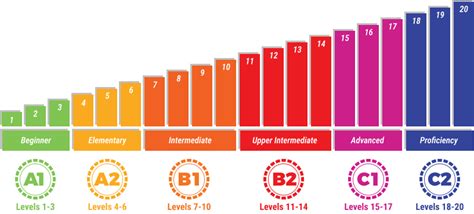Determining Your Spanish Proficiency
Assessing your Spanish proficiency is crucial for setting realistic learning goals and tracking your progress. Here are some tips to help you gauge your level:

Self-Assessment Tools
- Language Level Self-Assessment Grids: These tools provide a structured approach to evaluate your listening, speaking, reading, and writing skills. You can find these grids online or through language schools.
- Online Proficiency Tests: Numerous websites offer free or paid proficiency tests that simulate real-life language scenarios. These tests can provide an objective estimate of your level.
Common European Framework of Reference (CEFR)
The CEFR is an international standard for describing language proficiency. It divides language levels into six categories:
| Level | Description |
|---|---|
| A1 | Breakthrough |
| A2 | Waystage |
| B1 | Threshold |
| B2 | Vantage |
| C1 | Effective Operational Proficiency |
| C2 | Mastery |
Official Language Tests
- DELE (Diplomas de Español como Lengua Extranjera): These tests are administered by the Spanish Ministry of Education and offer official certification at various CEFR levels.
- SIELE (Servicio Internacional de Evaluación de la Lengua Española): This test is also administered by the Spanish Ministry of Education and provides a comprehensive assessment of all four language skills.
Factors to Consider
When assessing your level, consider the following factors:
- Fluency: How well can you express yourself in Spanish without hesitation or significant errors?
- Accuracy: How accurate is your grammar, pronunciation, and vocabulary?
- Comprehension: Can you understand native Spanish speakers in different contexts?
- Cultural Awareness: Do you have a basic understanding of Spanish culture and customs?
Tips for Improving Your Spanish
- Immerse Yourself: Surround yourself with Spanish by watching movies, listening to music, reading books, and interacting with native speakers.
- Practice Regularly: Dedicate consistent time to practicing your Spanish speaking, listening, reading, and writing skills.
- Use Language Exchange Apps: Connect with language partners online or through apps to practice speaking Spanish with native speakers.
- Take Classes or Lessons:Enroll in formal classes or lessons to receive structured instruction and feedback.
- Set Realistic Goals: Determine achievable goals to avoid discouragement and maintain motivation.
Breaking Down the CEFR Levels
A1 (Breakthrough)
- Listening: Understand basic phrases and slow speech on familiar topics.
- Speaking: Can introduce yourself, ask simple questions, and interact in basic conversations.
- Reading: Can read and understand short texts with limited vocabulary.
- Writing: Can write simple sentences and short personal notes.
A2 (Waystage)
- Listening: Can understand main points of clear speech on familiar topics.
- Speaking: Can discuss personal experiences, activities, and preferences.
- Reading: Can understand simple texts and articles on familiar topics.
- Writing: Can write short, coherent texts about familiar topics.
B1 (Threshold)
- Listening: Can understand the main ideas of extended speech and complex texts on familiar and unfamiliar topics.
- Speaking: Can express opinions and discuss abstract topics.
- Reading: Can read and understand most texts, including news articles and literature.
- Writing: Can write clear, detailed texts on a range of topics.
B2 (Vantage)
- Listening: Can understand complex speech and lectures on unfamiliar topics.
- Speaking: Can express ideas fluently and precisely.
- Reading: Can read and understand complex texts, including technical documents and literary works.
- Writing: Can write clear, well-structured texts for academic or professional purposes.
C1 (Effective Operational Proficiency)
- Listening: Can understand almost everything native speakers say, even in complex and demanding situations.
- Speaking: Can express oneself fluently, accurately, and effortlessly.
- Reading: Can read and understand a wide range of complex and specialized texts.
- Writing: Can write clear, well-organized, and persuasive texts.
C2 (Mastery)
- Listening: Can understand virtually everything native speakers say, including highly technical or idiomatic speech.
- Speaking: Can participate in spontaneous conversations, including discussions on complex or controversial topics.
- Reading: Can read and understand any type of written text, including specialized literature.
- Writing: Can write clear, well-organized, and precise texts on complex topics.
Creative Ways to Improve Your Spanish
- Language Exchange Meetups: Host or attend language exchange meetups to practice speaking Spanish with native speakers in a social setting.
- Spanish Language Podcasts: Listen to Spanish language podcasts to improve your listening comprehension and exposure to colloquial Spanish.
- Immersive Spanish Travel: Plan a trip to a Spanish-speaking country to surround yourself with the language and experience the culture firsthand.
- Spanish Language Apps: Utilize language learning apps that offer interactive games, lessons, and personalized practice exercises.
Useful Tables
Table 1: Approximate Timelines to Achieve CEFR Levels
| Level | Time with Daily Study |
|---|---|
| A1 | 6-12 months |
| A2 | 12-18 months |
| B1 | 18-24 months |
| B2 | 24-36 months |
| C1 | 36-48 months |
| C2 | 48+ months |
Table 2: CEFR Level Equivalents
| CEFR Level | ACTFL Proficiency Guidelines | American Council on the Teaching of Foreign Languages |
|---|---|---|
| A1 | Novice Low | Basic Speaker |
| A2 | Novice High | Beginning Speaker |
| B1 | Intermediate Low | Intermediate Speaker |
| B2 | Intermediate High | Advanced Speaker |
| C1 | Advanced Low | Superior Speaker |
| C2 | Advanced High | Distinguished Speaker |
Table 3: Common Assessment Methods for CEFR Levels
| Level | Assessment Method |
|---|---|
| A1 | Basic Language Task |
| A2 | Waystage Language Task |
| B1 | Threshold Language Task |
| B2 | Vantage Language Task |
| C1 | Effective Operational Proficiency Language Task |
| C2 | Mastery Language Task |
Table 4: Resources for Determining Your Spanish Level
| Resource | Type |
|---|---|
| Language Level Self-Assessment Grids | Self-Assessment Tool |
| Online Proficiency Tests | Self-Assessment Tool |
| DELE Exams | Official Language Test |
| SIELE Exams | Official Language Test |
